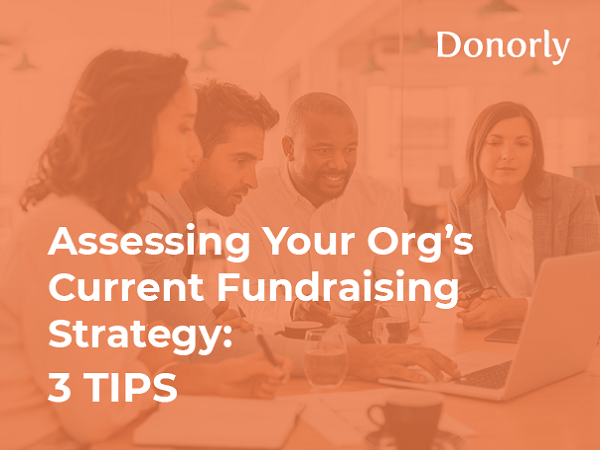
In order to move forward, you have to understand where you’ve been. Check out these three tips for assessing your nonprofit’s current fundraising strategy!
Say your nonprofit has just wrapped up a large fundraising campaign. You met your goal, but your team faced many challenges along the way, like dealing with outdated fundraising software, struggling to effectively communicate with your supporters, and having a disorganized approach to major-gift fundraising. While you’re glad that you met your goal, you know that you need to make some adjustments before your next fundraising campaign.
So, where do you start when it comes to updating your fundraising strategy? You have to begin by assessing your current fundraising strategy. After all, you can’t move forward without understanding where you’ve been. In this post, we’ll cover three tips for assessing your strategy so that you can set yourself up for future fundraising success.
1. Review your fundraising metrics.
Fundraising metrics (often called key performance indicators or KPIs) are measured values that your nonprofit can use to determine the success of your fundraising efforts. You can calculate your metrics using your nonprofit’s data.
According to DonorSearch, these are some useful metrics that your nonprofit can measure to assess its current success with fundraising:
- Cost per dollar raised (CPDR): You can determine the CPDR for a fundraising campaign (or set time period) by dividing the campaign expenses by the revenue generated by the campaign.
- Donor retention rate: This KPI tells you the percentage of donors your organization retains year-over-year. You can find it by dividing the total number of donors who gave last year and this year by the number of donors who gave last year and then multiplying by 100 to yield a percentage.
- Donor churn rate: On the flip side, donor churn rate tells you the percentage of donors who were not retained year-over-year. To calculate it, divide the number of lapsed donors by the number of donors who gave last year, and then multiply the resulting number by 100 to yield a percentage.
- Average gift size: This metric can help you determine the average donation amount given during a campaign, within a certain group, or in a set time period. To calculate this metric, divide the total dollar amount of donations received by the number of gifts received.
- Donor lifetime value (DLV): DLV enables you to quantify the overall value a given donor will have for your organization. To find it, multiply together three values: the average length of time an individual spends as an active donor, average donation amount, and average frequency of donation.
If your nonprofit has been tracking metrics for a while, you’ll be able to identify patterns and trends that will be useful to you as you work to improve your fundraising efforts.
But, if you’re new to tracking metrics, remember to give yourself enough time to determine the metrics you want to watch and to collect data and see changes in those metrics. Additionally, keep your data tidy and organized so that you have all the necessary information to gather accurate, actionable insights.
2. Work with a fundraising consultant.
To help you make objective decisions about your data and nonprofit fundraising strategy, you may want to get an outsider’s perspective by working with a fundraising consultant. They can step in and determine what is and isn’t working for the organization, and then make tailored recommendations for improvement.
Donorly's guide to hiring a fundraising consultant explains how the partnering process works:
- Determine what your organization needs from a consultant.
- Develop a request for proposal (RFP) that outlines your needs and expectations.
- Begin your search by getting recommendations from trusted colleagues and doing your own research.
- Meet with potential consultants and submit RFPs.
- Review the proposals you receive and choose the right consultant for your organization.
In addition to providing general fundraising strategy guidance, a consultant will often bring special expertise to the table. For example, they might be able to assist you in prospecting for more major donors or preparing for a capital campaign. Even if you don’t need services like these now, kickstarting a relationship with a consultant can help you know where to turn when you need help in specific areas down the line.
3. Ask your supporters for feedback.
Don’t overlook the value of asking your nonprofit’s community for feedback on your fundraising work. After all, your donors, volunteers, and sponsors are the ones you’re soliciting support from during your fundraisers.
Consider asking your supporters for feedback in one of the following ways:
- in conversation;
- through surveys; or,
- via a poll on your website.
As you work to gather feedback from your supporters, ensure that you’re asking specific questions. For example, you might seek feedback on your marketing strategy by asking questions like, “In the last month, how many times has our organization reached out to you?” or “What was the most memorable part of April’s newsletter?” This will not only help you gather information on one set topic but also help your team focus on improving that one area of its fundraising operations.
Before you make your next fundraising plan, take the time to assess your current fundraising strategy. As you leverage fundraising metrics, get advice from an experienced nonprofit consultant, and ask your community for feedback, you will be well-prepared to make adjustments to your fundraising approach that will lead to better results for your organization and beneficiaries. Good luck!
- Review your fundraising metrics, or, if you’re new to measuring metrics, determine which metrics you want to measure. Clean up your data so that you can ensure you have accurate information to work with.
- Consider working with a fundraising consultant that can provide a third-party perspective on your fundraising strategy and make tailored recommendations for improvement.
- Ask your supporters for feedback on specific areas of your fundraising strategy.